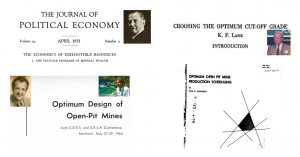Evolutionary algorithms address mine planning complexity
I’ve been working in the mine planning space for about 18 years and I’m constantly learning.
Similarly, I’ve found people in mining are very innovative and tend to embrace new techniques and solutions.
However, it seems that in mine planning we are still relying on techniques developed early 20th century.
In general, we are using technology based on the following major works:

- Harold Hotelling’s 1931 paper The Economics of Exhaustible Resources was the first to put mining in an economic context.
- Another mathematician, K.F. Lane, was one of the first to talk about mine optimisation with Choosing the Optimum Cutoff Grade in 1964.
- Perhaps most notably, in 1965 Helmut Lerchs and Ingo Grossman published Optimum Design of Open-Pit Mines and gave us the Lerchs-Grossman algorithm.
- Thys B. Johnson in his Optimum Open Pit Mine Production Scheduling work, made a major step by combining the optimal pit limit with the production schedule in 1968.
Technological limitations meant they were unable to solve complex real-world problems in a reasonable time.
It wasn’t until the 1980s that we started talking about commercial programs that could help solve mine planning problems.
In light of recent computational advances the time has come for us to expand our horizons and embrace new techniques.
How big is the challenge?
The mine planning problem has been classified as an NP-Hard Problem not only because of its complexity to solve but because of the difficulty in evaluating all of the options.
It means it will take an incredibly long time to evaluate all of the options to come up with the optimum.
When you start to think in real world scenarios incorporating non-linear constraints, cutoff grade, number of blocks, equipment and the non-linear interaction between the aforementioned, the problem is not amenable to classical techniques without simplification.
Some people don’t realise the computational complexity of these problems.

Mine planning is incredibly complex
In a scenario where you have six pushbacks, 12 benches and 10 periods you have 1.9×1033 combinations and if you want to measure the optimum you have to make sure you actually evaluate all of them.
To solve that issue most of the industry is trying to aggregate the data and simplify the problem, for example by running the problem without a stockpile or with a fixed cut off grade.
Being careful with assumptions
Simplification needs to be made due to the complexity and non-linearity of the problem.
A lot of commercial products in the market are based on linear techniques.
In addition to the non-linearity, many operations want to work with stockpiles and blending that adds to the complexity.
As you can see, mine planning is far from a linear system.
The state of the game
A 2019 McKinsey & Company report found that only 20% of surveyed mining and metals projects are completed within parameters predicted during feasibility.
So that means 80% are getting it wrong – that’s huge and means something is not right in the industry.
Is it that mine planners are not making the right assumptions in the feasibility study or our execution is not right?
How Maptek can help
For the past few years Maptek has been developing an optimisation framework which is based on genetic algorithms at its core.
They are very flexible and try to mimic Darwinian behaviour (i.e. survival of the fittest).
Genetic algorithms are powerful global search algorithms that make no assumptions with regards to objectives, constraints and variable interaction.
In contrast to classical techniques that manipulate a single solution, genetic algorithms manipulate a population of solutions.
This results in an implicit parallel exploration of the search space due to exchange of information between individual solutions.
This exploration of the search space and exploitation of the population results in a high quality solution.
Learning to hit a target, then doing so with a constraint in place
Source: Daniel Shiffman natureofcode.com
By relying on genetic algorithms, Evolution is able to optimise schedules using large models in a reasonable amount of time.
This enables users to maximise the value of deposits without compromising operations and without simplifying data.
As I said at the beginning I’m constantly learning in this industry.
One of the great things that I’ve learned is how computational models can unlock huge value for mine planning incorporating non-linear interactions between objectives, variables and constraints.
All the above enables us to focus more on the result instead of on simplifying the problem so it can fit our techniques.




